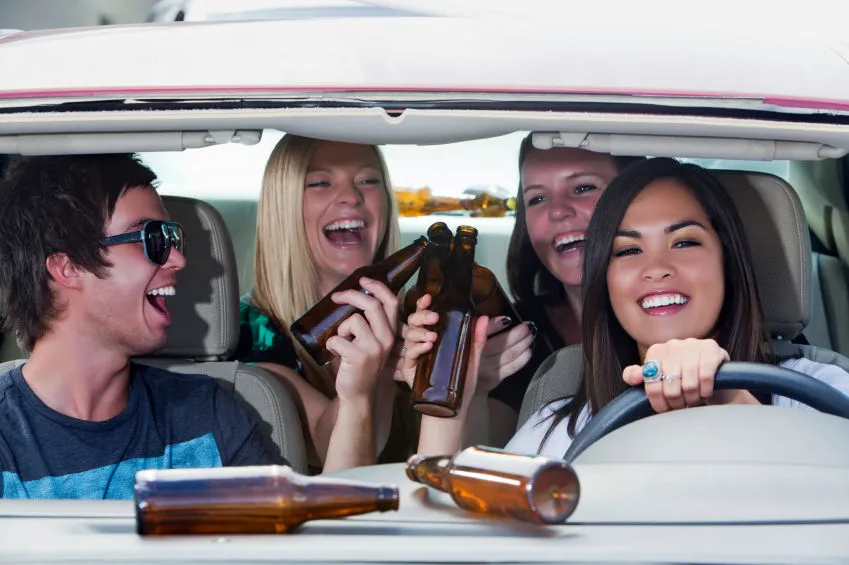The facts on teenage drunk driving remain a concerning issue, indicating not only a brief lapse of judgment but also a larger societal concern.
In 2020, 24% of deadly crashes that involved drivers aged 15-20 were linked to alcohol.
These statistics paint a harsh reality: young lives are put at risk and often lost, families are left shattered, and communities are left searching for solutions.
This article brings to light the dangers of teen drunk driving and encourages prevention measures to safeguard the lives of young people.
The Prevalence of Teenage Drunk Driving
Current Statistics on Teenage Drunk Driving Incidents:
Teenage drunk driving is a significant problem that needs to be addressed.
As per the National Highway Traffic Safety Administration (NHTSA), car accidents are the leading cause of death for teenagers in the United States, and around 25% of these accidents involve an underage driver who has consumed alcohol.1
In 2020, 19% of drivers aged 16-17 admitted to driving under the influence of alcohol at some point in the past year.2
These statistics indicate an ongoing challenge in the decision-making of young people regarding alcohol consumption and driving.
Comparison with Adult Drunk Driving Rates:
When comparing teenage and adult drunk driving rates, the statistics paint a complex picture.
Although adults tend to engage in drunk driving more often, teenage drunk drivers face more severe consequences.
Due to having a higher alcohol tolerance and more driving experience, adults may not exhibit impairment as quickly.
However, even small amounts of alcohol can significantly impair driving abilities for teens, whose bodies and driving skills are still developing.
This disparity highlights the need for interventions that are specifically designed for teenagers.
Factors Contributing to the Prevalence Among Teenagers:
Several factors contribute to the prevalence of drunk driving among teenagers, including:
• Inexperience with Alcohol and Driving: It is a fact that teenagers have less experience with both drinking and driving than adults. This lack of experience can lead them to make poor decisions, such as underestimating the effects of alcohol on their driving abilities or overestimating their ability to handle a vehicle while impaired.
• Peer Pressure: Adolescents are particularly susceptible to peer pressure and may engage in risky behaviors, like drinking and driving, to fit in or gain approval from friends.
• Sense of Invincibility: Many teenagers possess a feeling of invincibility and may not fully comprehend the dangers of driving under the influence, leading them to take risks they do not fully understand.
• Access to Alcohol: Despite legal restrictions, many teenagers find ways to access alcohol, which can lead to spontaneous and unprepared situations where they might choose to drive after consuming.
• Underdeveloped Judgment: The prefrontal cortex, responsible for judgment and decision-making, is still developing in the teenage brain, making them more likely to make impulsive decisions without considering the long-term consequences.3
It is crucial to understand these factors to create educational programs and preventive measures that resonate with teenagers, addressing not only the act of drinking and driving but also the underlying behaviors and societal pressures that contribute to this hazardous practice.
Legal Implications and Consequences
Overview of Legal Drinking Ages Worldwide and Variance in Laws:
Drinking age laws vary widely across the globe.
While most countries have set the minimum legal drinking age at 18 years, it ranges from 16 to 25 in some places.
For example, in Europe, 18 is the legal drinking age, whereas in the United States, it’s 21.
These differences reflect the cultural, historical, and social aspects of each country.
Moreover, the enforcement of these laws and the penalties for underage drinking also differ, with some countries having stricter controls and harsher punishments for violations.
Legal Consequences for Teenagers Caught Drunk Driving:
For teenagers caught drunk driving, the legal consequences can be severe and are often designed to serve as a deterrent.
They may include:
• Immediate Penalties: Suspension or revocation of the driver’s license, fines, and possible detention in juvenile facilities.
• Mandatory Education and Intervention: Enrollment in alcohol education or substance abuse programs.
• Community Service: Requirement to complete a set number of hours of community service.
• Probation: Being placed on probation might include regular check-ins with a probation officer and other restrictions.
• Ignition Interlock Devices: Installation of ignition interlock devices that require the driver to perform a breathalyzer test before the vehicle starts.
| Consequence: | Details: |
|---|---|
| Immediate Penalties | Suspension or revocation of driver’s license, fines, and possible detention in juvenile facilities. |
| Mandatory Education and Intervention | Enrollment in alcohol education or substance abuse programs. |
| Community Service | Requirement to complete a set number of hours of community service. |
| Probation | Being placed on probation may include regular check-ins with a probation officer and other restrictions. |
| Ignition Interlock Devices | Installation of ignition interlock devices requires the driver to perform a breathalyzer test before the vehicle starts. |
Long-Term Legal Repercussions (e.g., criminal record implications):
Teenage drunk driving can have long-term legal consequences that go beyond the immediate aftermath.
Depending on the jurisdiction and the severity of the incident, particularly if it resulted in an accident or injuries, the offense can lead to a criminal record that may have a significant impact on the teenager’s future.
• Employment Opportunities: Many employers conduct background checks, and a criminal record can limit job opportunities, particularly in fields that require driving or high security clearance.
• Education Prospects: Some colleges and universities take criminal histories into account during the admissions process, and a drunk driving conviction could impact a student’s ability to gain admission or secure financial aid.
• Insurance Rates: Insurance premiums can skyrocket for drivers with a DUI/DWI conviction, and in some cases, insurance companies may refuse coverage altogether.
• Travel Restrictions: Certain countries may deny entry to individuals with a criminal record, including for drunk driving convictions.
• Professional Licenses: Obtaining professional licenses (e.g., law, medicine, teaching) may become more complicated with a criminal record.
It’s crucial to teach teenagers about the seriousness of drunk driving and how it can affect their current and future lives.
Legal repercussions aside, drunk driving can have far-reaching consequences, including personal, professional, and social impacts on a young person’s life.
It’s important for them to understand the gravity of the situation and the wide-ranging effects their actions can have.
| Consequence: | Details: |
|---|---|
| Immediate Penalties | Suspension or revocation of driver’s license, fines, and possible detention in juvenile facilities. |
| Mandatory Education and Intervention | Enrollment in alcohol education or substance abuse programs. |
| Community Service | Requirement to complete a set number of hours of community service. |
| Probation | Being placed on probation may include regular check-ins with a probation officer and other restrictions. |
| Ignition Interlock Devices | Installation of ignition interlock devices requires the driver to perform a breathalyzer test before the vehicle starts. |
Physical and Psychological Impact on Teenagers
Short-Term Effects of Alcohol on the Teenage Brain and Body:
The teenage body is more vulnerable to the effects of alcohol because it is still developing.
Short-term effects can include:
• Impaired Judgment: Alcohol can affect the prefrontal cortex, the area responsible for judgment and decision-making, leading to poor choices.
• Loss of Coordination: Even small amounts of alcohol can affect motor skills, balance, and reaction times, increasing the likelihood of accidents.
• Memory Impairments: Alcohol can interfere with the ability to form new memories, sometimes resulting in blackouts.
• Risk of Alcohol Poisoning: Teenagers are at risk of misjudging their limits and may consume dangerous amounts of alcohol, leading to alcohol poisoning, which is a medical emergency.
Long-Term Health Risks Associated with Early Alcohol Use:
Early alcohol use can initiate patterns that have long-term health implications: • Brain Development: Prolonged alcohol use can affect brain development, potentially leading to cognitive deficits and diminished brain function. • Addiction: Adolescents who drink are more likely to develop alcohol dependence later in life due to changes in the brain’s reward systems.4 • Liver Damage: Chronic drinking can lead to liver diseases, including fatty liver, hepatitis, and cirrhosis, even at a younger age. • Mental Health Disorders: Early alcohol use is associated with an increased risk of developing mental health issues, such as depression and anxiety.Psychological Consequences of Engaging in Risky Behaviors:
Engaging in risky behaviors like drunk driving can have lasting psychological consequences for teenagers:
• Stress and Anxiety: The stress of legal consequences and the guilt of endangering themselves and others can lead to anxiety.
• Depression: The aftermath of a drunk driving incident, especially if it led to an accident, can be traumatic, potentially triggering depression.
• Social Isolation: Teenagers may feel isolated from peers or stigmatized by their community following a drunk driving incident.
• Impaired Social Development: Adolescence is a critical period for developing social skills; risky behaviors and their consequences can impair this development.
• Low Self-Esteem: Dealing with the repercussions of their actions can lead to feelings of worthlessness and a diminished sense of self-esteem.
The Risks of Teenage Drunk Driving
| Short-Term Effects: | Long-Term Effects: |
|---|---|
| Impaired judgment leads to poor decision-making | Potential for cognitive deficits and diminished brain function |
| Loss of coordination and increased risk of accidents | Increased risk of developing alcohol dependence |
| Memory impairments and potential for blackouts | Chronic liver diseases, such as fatty liver, hepatitis, and cirrhosis |
| Risk of alcohol poisoning, a medical emergency | Greater chance of mental health issues like depression and anxiety |
Increased Risk of Accidents and Fatalities:
Drinking and driving as a teenager can significantly increase the chances of being involved in a vehicular accident.
This is because alcohol affects judgment, reaction time, and motor coordination.
According to the Centers for Disease Control and Prevention (CDC), drivers aged 16 to 20 are 17 times more likely to die in a crash when they have a blood alcohol concentration (BAC) of 0.08% than when they haven’t been drinking.5
The risk of accidents increases as the level of alcohol in the bloodstream rises, and for teenagers who have less experience with both drinking and driving, the risk is even higher.
The Impact of Teenage Drunk Driving on Accident Severity:
Accidents involving teenage drunk drivers are more severe for various reasons.
Firstly, alcohol impairment can lead to riskier behaviors like speeding, driving without seat belts, and erratic steering.
Secondly, due to inexperience, teenagers may not be well-equipped to handle emergency driving situations.
Moreover, when alcohol is involved, crashes are more likely to occur at higher speeds and in more dangerous conditions, which can increase the severity of the accident and the likelihood of serious injury or even fatality.
Factors That Influence Teenage Drunk Driving
Peer Pressure and Social Dynamics:
Peer pressure is a powerful force in the lives of teenagers and can have a profound impact on their behavior when it comes to alcohol consumption and driving.
The need to fit in or be accepted by peers can make teenagers more inclined to engage in risky behaviors, such as drinking and driving.
Social events, parties, and gatherings where alcohol is present can create an environment where drinking becomes normalized, and not drinking may seem socially isolating.
Furthermore, if a teen’s friend group condones or even encourages drunk driving, the likelihood of a teen deciding to drive under the influence increases.
The Role of Family and Parental Influence:
The attitudes and behaviors of a family towards drinking, driving, and the combination of both play a vital role in shaping the perceptions and actions of teenagers.6 Parents who clearly communicate their expectations against drunk driving and demonstrate responsible behavior can decrease the likelihood of their children engaging in such activities. On the other hand, a family environment where alcohol consumption is frequent without discussing its risks can unintentionally reduce the seriousness of drunk driving. Parental monitoring, such as keeping track of where their teenagers are going, and who they are with, and enforcing curfews, can also serve as a protective measure against drunk driving.Media and Cultural Portrayals of Drinking:
Media and popular culture can greatly influence the attitudes of teenagers towards alcohol.
Movies, TV shows, music videos, and social media can often portray drinking as glamorous, fun, and without consequences, which can mislead young people about the actual risks involved.
This glorification can diminish the dangers of drinking and driving and create a disconnection between the perceived excitement and the potential negative outcomes in real life.
In the current era of social media, where platforms such as Instagram, TikTok, and Snapchat can influence teenagers, these portrayals can have a more significant impact, as the perception that “everyone is doing it” can further normalize the behavior.
It is essential to understand these influences to develop effective prevention strategies.
These strategies can include promoting healthy peer influences, family-based interventions, and media literacy programs that can help teenagers evaluate the messages they receive about alcohol consumption critically.
This can help them recognize the real dangers of drunk driving and make informed choices.
Preventative Measures and Education
Effective Strategies For Preventing Teenage Drunk Driving:
Effective strategies often involve a multifaceted approach that targets various aspects of a teen’s life, including:
• Graduated Driver Licensing (GDL): GDL programs allow young drivers to gain experience under less risky conditions. Provisions often include zero tolerance for alcohol, nighttime driving restrictions, and passenger limitations.
• Parent-Teen Driving Agreements: Contracts between parents and teens that set forth rules and consequences related to driving can clarify expectations and encourage responsibility.
• Sobriety Checkpoints: High-visibility enforcement can deter teens from drinking and driving due to the increased risk of getting caught.
• Safe Ride Programs: Ensuring that teens have access to alternative transportation options, such as designated driver programs or ride-sharing, can prevent the decision to drive after drinking.
• Social Norming Campaigns: These campaigns correct misconceptions about the prevalence of drinking and driving and promote positive behaviors.
The Role of Education in Schools and Communities:
Education plays a vital role in shaping teens’ attitudes and behaviors toward drinking and driving:
• School-Based Education Programs: Integrating curriculum on the dangers of drunk driving can influence students’ perceptions and choices.
• Community Education Initiatives: Community-led efforts, like town hall meetings and workshops, can engage both teens and parents in discussions about the consequences of drunk driving.
• Peer Education Programs: Programs that train teens to speak to their peers about drunk driving can be particularly effective, leveraging the influence of social networks.
Case Studies of Successful Prevention Programs:
There are several examples of successful prevention programs that have demonstrated effectiveness in reducing teenage drunk driving:
• Every 15 Minutes: An immersive program where students are confronted with the realities of drunk driving through simulated crashes, “living dead” activities, and mock funerals. It is designed to illustrate the potential frequency of drunk driving fatalities.
• SADD (Students Against Destructive Decisions): A student-led organization that provides tools, resources, and support to students to help them navigate the pressures of adolescence, including those related to drinking and driving.
• MADD (Mothers Against Drunk Driving): This organization has been instrumental in raising public awareness and shaping policies related to drunk driving. Their youth programs aim to educate teens about the dangers of alcohol use and impaired driving.
To refine prevention strategies and develop best practices for reducing teenage drunk driving, it’s crucial to evaluate the success of various initiatives.
The community-wide approach to education and prevention is the most successful program, which involves schools, families, law enforcement, and teenagers themselves.
By engaging all of these parties, we can foster a comprehensive approach to reduce teenage drunk driving.
Supporting Teen Sobriety and Safe Driving
Resources for Teens Struggling with Alcohol:
There are numerous resources available for teenagers who are struggling with alcohol, ranging from confidential helplines to therapy and support groups:
• Helplines and Text Lines: Services like the Substance Abuse and Mental Health Services Administration (SAMHSA) helpline provide confidential, free advice.
• Counseling and Treatment Programs: Individual counseling, family therapy, and outpatient or inpatient treatment programs can offer tailored support for overcoming alcohol issues.
• Support Groups: Groups such as Alateen, part of the Al-Anon fellowship, are designed specifically for young people affected by another’s drinking and can also be a supportive space for teens struggling with their alcohol use.
Alternatives to Driving Under the Influence:
To prevent teens from driving under the influence, providing practical alternatives is key:
• Designated Driver Programs: Encouraging groups of friends to choose a designated driver who stays sober can ensure everyone gets home safely.
• Safe Ride Programs: Schools and communities may organize safe ride programs, especially during prom or graduation season, to give teens a reliable transportation option.
• Public Transportation and Taxis: Educating teens on the availability and schedules of public transportation and having taxi numbers handy can offer alternatives to driving.
How Technology Can Help:
Technology can play a significant role in preventing drunk driving among teenagers:
• Ridesharing Apps: Apps like Uber and Lyft provide a convenient alternative to driving and can be used on the spot when a teen finds themselves in a situation where driving is not safe.
• Breathalyzer-Linked Ignition Locks: While typically used as a court-mandated device for those who have already been convicted of DUI, personal breathalyzer devices for vehicle ignitions can also be a preventative tool.
• Safe Driving Apps: There are apps designed to disable a phone while driving to minimize distractions. Other apps can allow parents to monitor driving behavior or disable the vehicle if alcohol is detected.
• Social Media and Campaigns: Social media campaigns can positively leverage influence and peer pressure, promoting sobriety and safe driving habits through hashtags and online communities.
• Educational Apps: Interactive apps that educate on the effects of alcohol and simulate the impairment it can cause can be an eye-opening tool for teens.
To effectively reduce drunk driving incidents among teenagers, it is essential to include various resources and technologies as a part of a comprehensive strategy that supports teen sobriety and safe driving.
Developing an environment that encourages seeking help and selecting safer alternatives is equally crucial.
This can be achieved by normalizing and promoting such choices through community support, policies, and technology.
Steering Clear of Harm: Uniting to Combat Teenage Drunk Driving
Teenage drunk driving is a dangerous behavior that can have severe consequences.
To prevent it, the community must come together and take a multifaceted approach.
This includes not only educating teenagers but also involving parents, educators, and policy-makers, and using responsible technology.
By having ongoing conversations about the risks of drunk driving and providing support systems that encourage responsible decision-making, we can help guide young people towards safer roads and brighter futures.
Let us commit to this ongoing effort, for every life saved is a promise to our collective well-being and a testimony to the power of our community.
Comprehensive DUI Education and Alcohol Rehabilitation
If you or someone you know is dealing with the consequences of driving under the influence or struggling with alcohol addiction, Cornerstone DUI in Arizona is here to help.
We offer a wide range of services, including DMV and MVD-approved online DUI classes, Alcohol Screenings, and DUI Screening Assessments, all of which can be accessed remotely for your convenience.
Cornerstone also provides holistic alcohol addiction rehab treatment services that aim to promote long-lasting recovery.
Our approach is designed to care for every aspect of your well-being, laying the foundation for a resilient and sober future.






